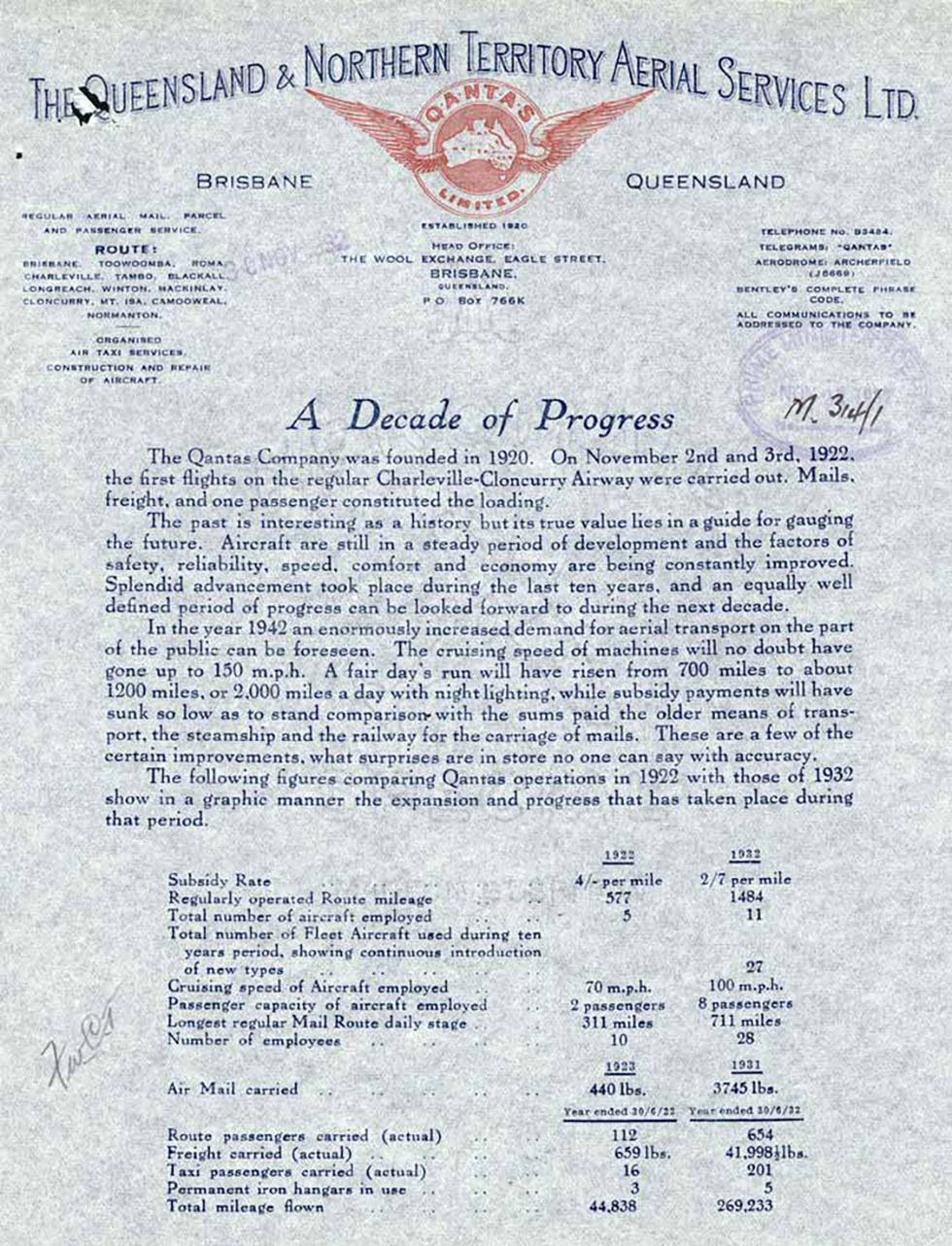


Transcript
[Letterhead in blue ink for 'THE QUEENSLAND & NORTHERN TERRITORY AERIAL SERVICES LTD.' Logo in red ink between the words 'BRISBANE' and 'QUEENSLAND' shows a map of Australia in a winged circle, with the text 'Q.A.N.T.A.S. LIMITED.' written around the edge of the circle.]
[The letterhead continues in three columns. Left column:]
REGULAR AERIAL MAIL, PARCEL AND PASSENGER SERVICE.
ROUTE:
BRISBANE, TOOWOOMBA, ROMA, CHARLEVILLE, TAMBO, BLACKALL, LONGREACH, WINTON, MACKINLAY, CLONCURRY, MT. ISA, CAMOOWEAL, NORMANTON.
ORGANISED AIR TAXI SERVICES,
CONSTRUCTION AND REPAIR OF AIRCRAFT.
[Centre column:]
ESTABLISHED 1920
HEAD OFFICE:
THE WOOL EXCHANGE, EAGLE STREET.
BRISBANE,
QUEENSLAND.
P.O. BOX 766K
[Right column:]
TELEPHONE NO. 53484
TELEGRAMS: "QANTAS"
AERODROME ARCHERFIELD (J8669)
BENTLEY'S COMPLETE PHRASE CODE.
ALL COMMUNICATIONS TO BE ADDRESSED TO THE COMPANY.
[End of letterhead.]
[Stamped in blue ink: '30 NOV 1932'.]
[Stamped in blue ink: 'PRIME MINISTER'S DEPT', 'NOV 21 1932', with handwritten reference number 'M. 314/1' written inside stamp.]
[Heading:] A Decade of Progress
The Qantas Company was founded in 1920. On November 2nd and 3rd, 1922, the first flights on the regular Charleville-Cloncurry Airway were carried out. Mails, freight, and one passenger constituted the loading.
The past is interesting as a history but its true value lies in a guide for gauging the future. Aircraft are still in a steady period of development and the factors of safety, reliability, speed, comfort and economy are constantly improved. Splendid advancement took place during the last ten years, and an equally well defined period of progress can be looked forward to during the next decade.
In the year 1942 an enormously increased demand for aerial transport on the part of the public can be foreseen. The cruising speed of machines will no doubt have gone to 150 m.p.h. A fair day's run will have risen from 700 miles to about 1200 miles, or 2,000 miles a day with night lighting, while subsidy payments will have sunk so low as to stand comparison with the sums paid the older means of transport, the steamship and the railway for the carriage of mails. These are a few of the certain improvements, what surprises are in store on one can say with accuracy.
The following figures comparing Qantas operations in 1922 with those of 1932 show in a graphic manner the expansion and the progress that has taken place during this period.
[The following information is presented as a table with a column titled '1922', and a column titled '1932'.]
Subsidy Rate[:] 4/- [4 shillings] per mile[;] 2/7 [2 shillings, 7 pence] per mile[.]
Regularly operated Route mileage[:] 577[;] 1484[.]
Total number of aircraft employed[:] 5[;] 11[.]
Total number of Fleet Aircraft used during ten years period, showing continuous introduction of new types[:] 27[.]
Cruising speed of Aircraft employed[:] 70 m.p.h.[;] 100 m.p.h.
Passenger capacity of aircraft employed[:] 2 passengers[;] 8 passengers[.]
Longest regular Mail Route daily stage[:] 311 miles[;] 711 miles[.]
Number of employees[:] 10[;] 20[.]
[New column headings: '1923' and '1931'.]
Air Mail carried[:] 440 lbs.[;] 3575 lbs.
[New column headings: 'Year ended 30/6/22' and 'Year ended 30/6/32'.]
Route passengers carried (actual)[:] 112[;] 654[.]
Freight carried (actual)[:] 659 lbs.[;] 41,998 ½ lbs.
Taxi passengers carried (actual)[:] 16[;] 201[.]
Permanent iron hangars in use[:] 3[;] 5[.]
Total mileage flown[;] 44,838[;] 269,233[.]
[Handwritten annotation in left margin:] F.W.C.T.
Need help with your research?
Learn how to interpret primary sources, use our collection and more.

